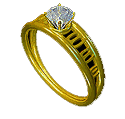Diamond Guide
DIAMOND FACTS | DIAMOND BUYING GUIDE | DIAMOND FAQ'S | RINGS
Diamond Color | Diamond Clarity | Diamond Weight | Diamond Cut | Diamond Fluoroscence | Diamond Certificates | Diamond Rings, Bracelets & Earrings.
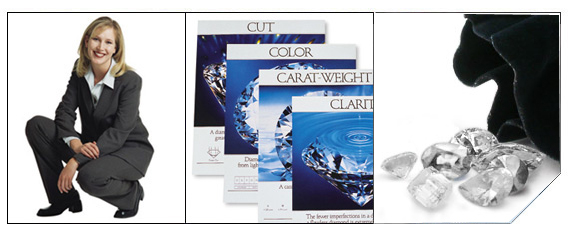
AGS: The American Gem Society. Begun in 1934, the AGS is an independent grader that sets the ethical standard in the jewelry industry as the recognized leading authority for grading diamonds and gemstones.
Blemish: A physical flaw on the diamond's surface caused usually by a scratch or abrasion of some kind.
Blue-White: A particular diamond that fluoresces, or glows, under ultra-violet light.
Brilliance: The amount of light reflected through the surface of a diamond.
Brilliant Cut: A style of diamond cutting that creates many facets of different shape and size. This increases a diamond's brilliance by minimizing the amount of light that can escape through the bottom of the stone.
Carat: The unit of weight by which a diamond or other gemstone is measured. It equals 200 milligrams. The word is derived from the carob bean, whose consistent weight was used in times past to measure gemstones.
Carbon Spots: Black spots in diamonds, usually caused by the presence of transparent crystals within the diamond.
Clarity: The measure by which a diamond is graded for purity, or whiteness. This is done by taking in the presence or absence of blemishes on the diamond's surface, or inclusions within the diamond. The professional grading scale is: flawless; internally flawless; very, very slightly included; very slightly included; slightly included; imperfect.
Cleavage: The propensity of crystalline minerals to split in one or more directions either along or parallel to certain planes, when struck by a blow. This is true of diamonds and certain other gemstones.
Clouds: Hazy or milky areas in the interior of the diamond, caused by extremely tiny crystals.
Color Grading: A system of grading diamonds on the quality of their tint, from colorless to a pronounced yellow hue. Modern methods use letters to designate differences in colors. They are D-F, for colorless; G-J, for nearly colorless; K-M, for faintly yellow; N-R, for very light yellow; S-X, for light yellow; Y-Z, for yellow. The traditional method ascribes names to the variations in tint: pure white (extra river; river), top-white (wesselton), off-white (silver cape, tope cape, cape, dark cape), yellow, and brown.
Color Grading: A system of grading diamonds on the quality of their tint, from colorless to a pronounced yellow hue. Modern methods use letters to designate differences in colors. They are D-F, for colorless; G-J, for nearly colorless; K-M, for faintly yellow; N-R, for very light yellow; S-X, for light yellow; Y-Z, for yellow. The traditional method ascribes names to the variations in tint: pure white (extra river; river), top-white (wesselton), off-white (silver cape, tope cape, cape, dark cape), yellow, and brown.
Colors: The full spectrum of hues found in natural, untreated diamonds. Completely colorless stones are as valuable as they are scarce. Generally, a stone will range from white to bluish to shades of yellow and brown. Fancy color diamonds have been found in variations of rose, green, blue, violet, pink, canary-yellow, brown and black. The true red diamond does exist, but it is an extremely rare find.
Crown: The upper portion of a cut gemstone, above the girdle.
Culet: The tiny facet on the pointed bottom of the pavilion, which is the portion of a cut gem below the girdle.
Cut: This refers both to the geometric proportions of a gemstone, and the final form into which a rough stone is shaped. The most prominent cuts in the industry are the round brilliant, oval, marquise, pear, heart, emerald, princess, trilliant, and radiant.
Depth: The height of a gemstone, from the culet to the table.
Depth Percentage: The height of the gemstone from culet to table, divided by the gemstone's width. Depth is a critical factor in creating a diamond's fiery brilliance.
Diamond: A stone of pure crystallized carbon, and the hardest substance known. It has a high refractive index and strong color dispersion.
Diamond Cutting: The method by which a crude diamond is shaped into a finished, faceted stone. Cleaving or Sawing removes the flawed portions of the stone, Bruting gives it its somewhat rounded shape, and Grinding creates the facets.
Diamond Gauge: An instrument that is used to estimate diamond weight in a setting.
Dispersion: A diamond's traditional 'fire'. It is the colored light that is reflected from inside a diamond.
Emerald Cut: A rectangular-shaped diamond with cut corners. It is also known as a Step Cut, because its broad, flat planes resemble stair steps.
Eye-Clean: A diamond with no blemishes or inclusions visible to the naked eye.
Facet: The small, flat, planed and polished surface on a cut diamond. Facets come in various shapes, sizes and arrangements, depending on the cut of the stone. In a round brilliant diamond the facets include the table, star, bezel, upper and lower girdle, girdle, and pavilion facets.
Fancy Shape: Occasionally referred to as Fancies, these are any shape diamond except round.
Feathers: Cracks of different sizes sometimes found in a diamond. They don't weaken the diamond and often are difficult to see.
Fire: The reflection of colored light from within a diamond, through the crown. When a diamond is cut to the proper proportions and the faceting is excellent, the resultant high dispersion and refraction of light leads to increased brilliance, or fire.
Fluorescence: The glow and color that certain diamonds emit when exposed to ultraviolet light.
GIA: The Gemological Institute of America. Founded in 1931 by Roger Shipley, this non-profit organization is an independent grader that upholds the highest standards for grading diamonds and other precious gems. The GIA is considered the highest authority in the industry.
Girdle: The narrow rim of a diamond that separates the crown from the pavilion. It is the largest diameter to any part of the stone. Usually it is left in an unpolished, or bruted state, with a matte finish. However, to achieve more overall brilliance for the diamond, the girdle is often ground.
Head: This refers to that portion of the diamond where prongs secure the stone in its setting.
Heart Cut: A pear-shaped diamond with a cleft at the top.
Inclusion: An inclusion is a flaw found within a diamond or on its surface, and was created when the gem formed in the earth. Internal inclusions are generally minute trace minerals, and external inclusions are usually fractures.
Laser-Drilled: A process by which a diamond is treated with a laser to remove dark carbon spots.
Marquise Cut: An elongated shape with pointed ends.
Naturals: A portion of the original surface of the diamond, left unpolished.
Off-Make: A diamond of bad proportions.
Pave: A style of diamond setting in which numerous small faceted stones are massed close enough to create a glistening diamond crust that covers the whole piece and obscures the metal under it.
Oval Cut: An elongated, perfectly symmetrical oval design.
Pavilion: The lower portion of the diamond, below the girdle. It is sometimes referred to as the base.
Pear Cut: A hybrid cut, shaped like a sparkling teardrop and combining the best elements of the Marquise and Oval cuts.
Point: One-hundredth of a carat.
Princess Cut: A square cut with numerous sparkling facets. Quadrillion Cut: Patented by Amber Diamonds in 1981, this is a square diamond with 21 facets on the crown, 24 on the pavilion, and four on the girdle.
Radiant Cut: Essentially, a brilliant-cut square or rectangular diamond with 70 facets and clipped-off corners, similar to an emerald cut.
Semi-mount: A setting complete but for the main stone, to be selected separately. Single-cut: A diamond of only 16 or 17 facets.
Sparkle: The reflective light of a diamond produced by its brilliance and its fire (also known as dispersion).
Symmetry: A description of the uniformity of a diamond's cut.
Table: This is the large, flat top facet of a diamond. The ratio of table size to crown angle creates the balance between a diamond's brilliance and its play of color. Each specific cut of diamond has a table ratio. The round brilliant has a ratio of 52.4 % - 57.5 %; the princess and radiant cuts have a ratio of 65 % - 80 %; the marquise, oval and pear have a ratio of 50 % -62 %; and the emerald has a ratio of 50 % - 75 %.
Tiffany: Known for its simplicity and elegance, this is a famous ring setting of 2mm to 3mm, holding a single diamond.
Trilliant Cut: A rounded triangular shape with 25 facets on the crown, 19 facets on the pavilion, and a polished girdle.
DIAMOND GUIDE: Diamond Color | Diamond Clarity | Diamond Cut | Diamond Weight
SHOP: Diamond Bands | Diamond Bracelets | Diamond Earrings | Diamond Engagement Rings

Diamond Color
We think diamond color is one is one of the most important factors to consider when selecting a diamond because it is one of the first things most people notice-whether or not the diamond is "white". It is also one of the most significant factors affecting value. D: The clearest diamond color grade, which is very rare. View Diamond Color Details.
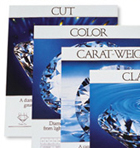
Diamond Clarity
Diamonds that are absolutely clean are very much in demand and are therefore the most expensive. But most of the diamonds have inclusions — scratches, trace minerals or other tiny characteristics that can detract from the pure beauty of the diamond. The GIA diamond report summarizes all these. View Diamond Clarity Details.
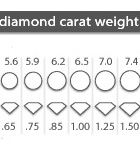
Diamond Carat Wt
Diamonds are sold by the carat (ct)-not to be confused with karat (kt), which refers to gold quality in the Unites States. Once you've determined what diamond cut, diamond color, and diamond clarity grade you're looking for in a diamond, it's easy to determine the carat weight of diamond that will fit within your budget. View Diamond Weight Details.
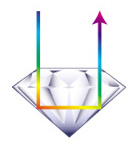
Diamond Cut
Diamond Cut: In its natural state, a diamond's beauty is generally concealed. While nature determines a diamond's color, clarity, and carat weight, the hand of a master craftsman is needed to release its fire and beauty. What draws out its brilliance is the cut of the diamond, which under ideal circumstances maximizes the optical properties within the diamond, particularly its ability to refract light and disperse color. View Diamond Cut Details.
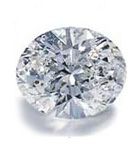
Diamond Fluoroscence
Fluorescent diamonds, especially the extreme rare cases known as overblues, give a diamond a visible haziness that undervalues them on the market. They appear almost cloudy in light with strong ultraviolet content, which compromises their clarity and decreases their appeal. Strongly fluorescent diamonds with yellowish body color have the appearance of better, whiter color in sunlight, a source of ultraviolet light. View Diamond Fluoroscence Details..

Diamond Certificates
A diamond certificate is a "blueprint" of a diamond, it tells you the diamond's exact measurements and weight, as well as the details of its cut and quality. It precisely points out all the individual characteristics of the stone. Certificates also serve as proof of the diamond's identity and value. Note that a certificate is not the same thing as an appraisal. A certificate describes the quality of a diamond, but it does not place a monetary value on the gem. View Diamond Certification Details.
